The Chuwi AeroBook Review: One Small Step For Chuwi
by Brett Howse on June 21, 2019 8:00 AM ESTBattery Life
The AeroBook offers a 38 Wh battery capacity, which is certainly on the low side for a 13.3-inch notebook. As a comparison, the Microsoft Surface Pro 6 squeezes a 45 Wh battery into a 12.3-inch tablet. But, the battery size is only one side of the equation, with the other being how efficient the device is. To see how Chuwi’s AeroBook performed, we ran it against several tests. As usual, all devices are calibrated to 200 nits of display brightness.
Light Battery
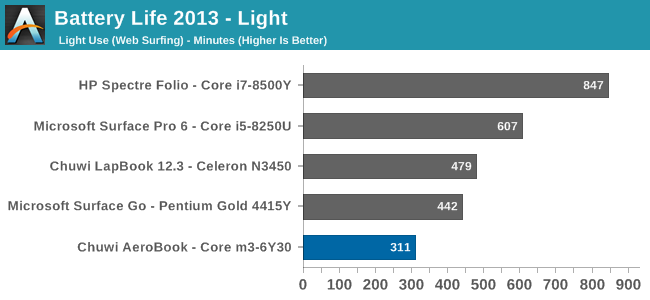
Our lightest test cycles four web pages per minute. On a modern laptop, it’s almost a test of idle, since the device is only working for a fraction of the time. Chuwi doesn’t fare well here. At just over five hours of runtime, it’s well below the average for this class of notebook.
Web
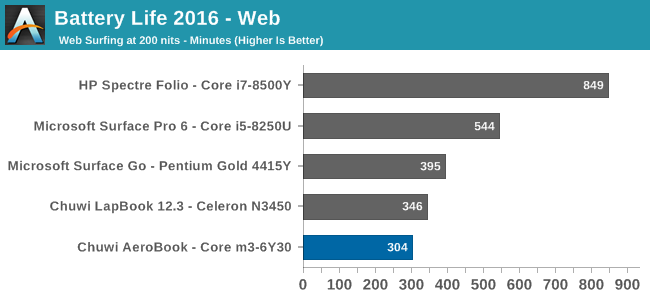
Our newer web test is much more demanding, and as such can drop the results significantly. That isn’t really the case with the AeroBook, which almost has the same runtime as the previous test, which hints that the main power drain isn’t the CPU at all.
Movie Playback
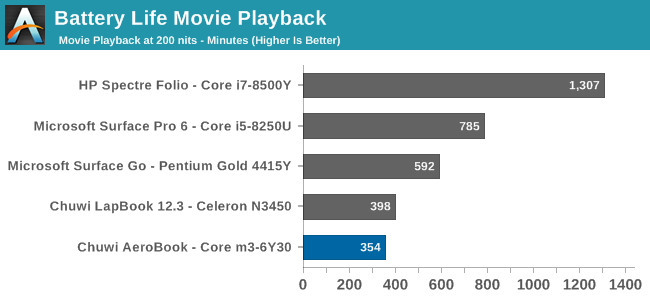
Our movie playback test simply cycles a movie until the battery quits. This test allows the device to move the work to fixed function hardware in the GPU, and lets the rest of the CPU sleep, so movie playback tends to be the longest running time of any of our tests. That is the case here as well, although the gain still isn’t enough to bring the AeroBook up from last place.
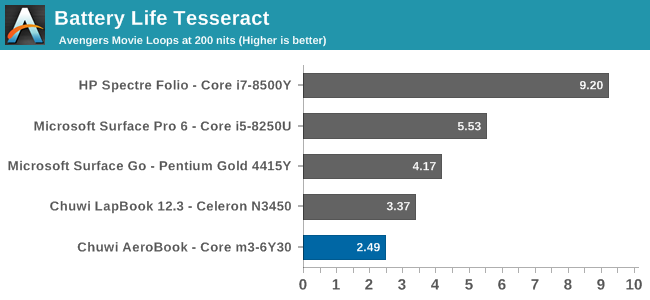
Our Tesseract score divides the movie playback by the length of a long movie, to give a quick and easy reference of how many movies can be played before the system runs out of power. If you’re on a long flight and want to watch some films to pass the time, you have to hope there’s a power outlet because the AeroBook doesn’t score well here.
Normalized Results
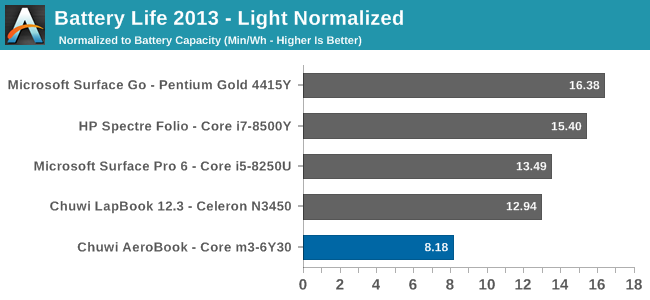
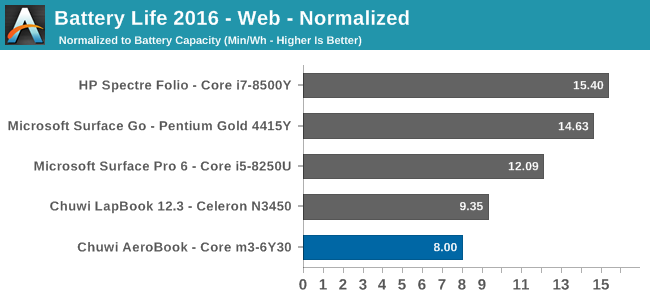
By removing the battery capacity from the total run time, we can see how efficient each device is, in a result of minutes of runtime per Wh of battery. The AeroBook is well off the best results here, meaning it’s the least efficient of the devices compared against. The worst part for the AeroBook is that it also offers one of the smallest batteries, so the battery life is impacted on both sides of this equation.
Platform Power
There’s more to making a laptop have great battery life than choosing a CPU. Every single decision made in the design has an impact on the battery life one way or another. Chuwi choosing a smaller battery capacity wouldn’t be a big issue if they also focuses on platform efficiency and display power draw, but it appears they did neither.
The power usage was checked with the machine idling at 200 nits display brightness, and also with the display off, to separate the power of the motherboard from the display, which tends to be the biggest draw on any notebook.
The display power on the AeroBook at 200 nits was 3.66 Watts, which is quite high. The HP Spectre Folio offers one of the new “1W” displays, and at maximum brightness it only draws 1.71 Watts, or half of what the Chuwi draws at 67% brightness to hit 200 nits. On top of that, the rest of the Chuwi draws 2.85 Watts at idle, which is at least 50% higher than expected. The same HP Spectre Folio with a Y-Series processor draws just 750 mW, and a much more powerful Surface Book 2 15 draws only 2 W at idle.
There could be many factors why. The Netac SSD may just offer terrible idle power management, or some other component that was chosen just has a high base power draw. The end result though is poor power management on a device with a small battery, meaning poor battery life.
Charge Time
The other side of the equation is charge time, and Chuwi ships the AeroBook with a 24-Watt AC Adapter. Unfortunately, the charging adapter is fitted with a barrel connector since the AeroBook, despite offering USB Type-C with power delivery, it doesn't ship with a USB-C charger, but if you ever do lose or break the flimsy barrel connector charger, you can utilize a USB Type-C charger in its place.
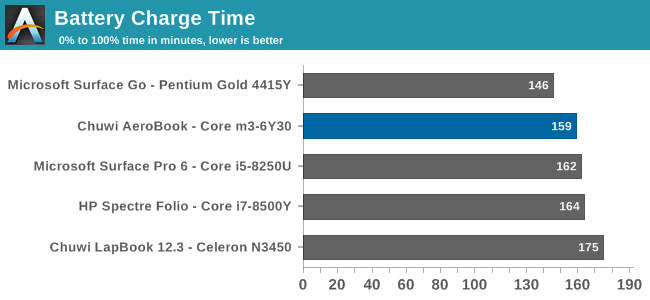
The overall charge time isn’t extremely fast, despite the small battery, but it does slot in about average with most notebooks.










51 Comments
View All Comments
bubblyboo - Friday, June 21, 2019 - link
US-warranty vs no warranty is also pretty unfair.nandnandnand - Sunday, June 23, 2019 - link
Marlin and levizx are right. The sucker price is for suckers. There's something on sale in any given category at any moment. Go back a year or two and the main difference in a laptop will be the specific CPUs and GPUs, so judge price/perf accordingly.systemBuilder - Friday, July 19, 2019 - link
You can think of the "m" series of processors as "bringing the Atom Slowness to the Pentium Line of CPUs". In other words, when you spend 90% of your life thermally throttled because the device is stupid-thin AND stupid-light, you suffer a great deal... I prefer my Acer Chromebook c720 i3.Urthor - Saturday, June 22, 2019 - link
You have to understand the pressure that Intel puts on sellers with the prices of its CPUs to OEM'sSecondhand laptops have been FAR cheaper for a LOT longer because ultimately Intel's control of the key part stops them discounting.
mkozakewich - Friday, June 21, 2019 - link
Chuwi are a cheap manufacturer that have been known to ship cheap parts that fail, and they won't respond to warranty requests unless you can post a video to YouTube (seriously, what) showing some kind of physical damage.yeeeeman - Friday, June 21, 2019 - link
For 250$, maybe, but for 500...no wayabufrejoval - Friday, June 21, 2019 - link
I got the Lapbook 12.3 after the review here.The main attraction was the high-resolution (3k) screen and totally silent operation for e-books and surfing. And while my first unit had a defective space-bar and completely unusable touchpad (way too sensitive), the second one was rather better with both, and delivered on the performance and usability criteria.
I moved Windows 10 immediately to a 128GB M.2 SSD and then put a Ubuntu 18.04 on the eMMC, mostly because I needed a little more space anyway and to avoid slowing the machine via the storage.
The disappointment came when I unpacked the ChuWi in the hotel after a flight and found it all bent out of shape from a battery that had gassed out, because a replacement battery cannot be bought from anyone or anywhere: ChuWi simply does not sell spare parts.
It’s easy enough to replace, a couple of screws and unplugging a connector, but without a spare part, it’s life is essentially ended before a year is full.
After a bit of howling and screaming they did offer me to send it to HongKong for a free replacement, and I am torn between using it just on external power or actually see if it gets back fixed.
I’m not sure I can attribute the battery failure to a quality defect on their side, though.
It’s the second time the very same thing happened to me and the other one was a Gigabyte mobile workstation at 10x the price (no issue with the spare parts there).
I believe the fault actually lies with Windows.
When I hibernate a notebook, I expect it to stay powered off until I power it up again. But Windows these days has so much AI, it knows better and seems to wake up hibernated (not just suspended) machines for things like regular reports to Redmont.
Since some of my machines are configured to actually boot Ubuntu, CentOS or Fedora by default, that is especially useless, because the Windows induced wakeup has them boot an OS that didn’t even ask for that.
In the confines of rucksack in an overhead locker then, these machines can easily overheat and cook the batteries until they’re dead.
I have tried very hard to find a recipe to keep these wakeups from happening. I really do like the ability to keep documents and VMs open (and hibernated on SSD), while I travel.
So far the only way to avoid these wakeups, seems to be removing the power supply before hibernating the machines: At that point “hibernate” seems to be actually understood by Microsoft as meaning “don’t wake automagically so you don’t fry batteries by accident in an airplane”.
I have started using that approach on commutes, but for longer trips, I do shut down those laptops, because the risk of unwarranted wakeups is too high.
So there you have it: ChuWis don’t disappoint as hardware per se, but spare parts or service are not included at this price.
olafgarten - Friday, June 21, 2019 - link
Windows doesn't wake hibernated laptops unless some hardware connected to it issues a wakeup signal. You either accidentally hit the on button or you have a faulty keyboard wakeup key.Also if you are using Ubuntu as the main OS, you are probably booting into Grub and so Windows has no control over the wakeup.
abufrejoval - Friday, June 21, 2019 - link
And so would I have sworn, perhaps not on my life, but at least a case of beer...I was far more inclined to blame the flying or even the security scanners at the airport.
Yet major problems there would be hard to hide...
And then I got a Lenovo S730 ultrabook to replace it and observed it for days.
Hibernated it (hybrid disabled) and was very surprised to watch it power up and boot whatever happend to be configured as primary in the BIOS, ... and that changed between Windows 10 1903 and Fedora 30, depending on what was more frequently used.
Mind you, I disconnected all external devices, nothing and nobody touching it, the power button requires quite a bit of force to exercise, but within half an hour to a full one it would power on again.
Now, I am pretty sure, that nobody in my network sends magic packets or patterns, and in any case I disabled that too, but no change. There are dozens of jobs scheduled in Windows and I deleted quite a few of those, mostly the "calling home" type. Also stopped and disabled the "user experience service" etc.
But so far the only thing that changed the behavior was to change the unplugging and the hibernate sequence: With the power plugged in at hibernate, Windows seems to assume it's ok to run scheduled jobs. Without external power, "hibernate" is "hibernate".
And these days, when you say "shut down" on Windows, you have to uncheck a hidden option in Windows to actually *make* it shut-down. Otherwise it will be 'smart' enough to assume that restarting Windows more quickly is more important and interpret "shutdown" as suspend-with-fast-restart...
And I have seen similar behavior in desktops that were *suspended* to RAM, with all magic packets and PS/2 as well as USB events disabled in BIOS to cause power up.
On those systems, massive amounts of RAM and SATA SSDs made hibernation less attractive and standby seemed a good compromise...
Here on the Lenovo RAM is stuck as 16GB and the NVMe will restore RAM at 3GB/s...
But "wakeup2die" isn't really attractive.
Perhaps we could get a little more end-user data on this?
Mil0 - Sunday, June 23, 2019 - link
I've seen this behavior as well, using MSI/Acer laptops, so it's not limited to some manufacturers.Thanks for the no-power-when-hibernating trick, I'll use that from now on.
It's a bit silly that there is no thermal protection on the battery - should be a pretty easy/cheap fix.